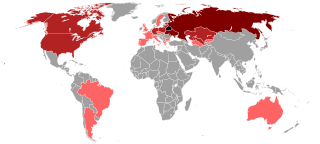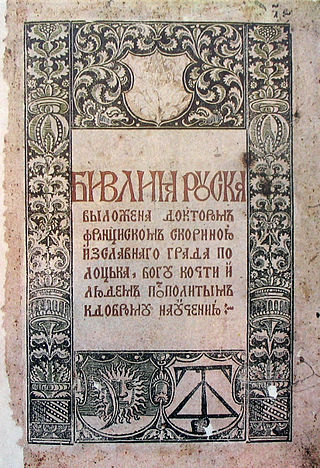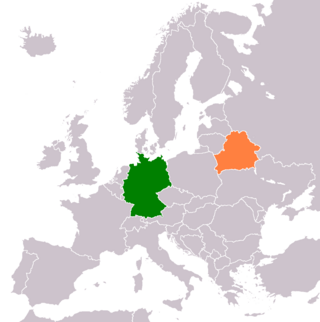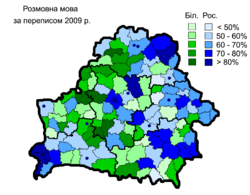
Belarus, officially the Republic of Belarus, is a landlocked country in Eastern Europe. It is bordered by Russia to the east and northeast, Ukraine to the south, Poland to the west, and Lithuania and Latvia to the northwest. Covering an area of 207,600 square kilometres (80,200 sq mi) and with a population of 9.2 million, Belarus is the 13th-largest and the 20th-most populous country in Europe. The country has a hemiboreal climate and is administratively divided into six regions. Minsk is the capital and largest city; it is administered separately as a city with special status.
The East Slavic languages constitute one of three regional subgroups of the Slavic languages, distinct from the West and South Slavic languages. East Slavic languages are currently spoken natively throughout Eastern Europe, and eastwards to Siberia and the Russian Far East. In part due to the large historical influence of the Russian Empire and the Soviet Union, the Russian language is also spoken as a lingua franca in many regions of Caucasus and Central Asia. Of the three Slavic branches, East Slavic is the most spoken, with the number of native speakers larger than the Western and Southern branches combined.

Belarusians are an East Slavic ethnic group native to Belarus. More than 9.5 million people proclaim Belarusian ethnicity worldwide. Nearly 8 million Belarusians reside in Belarus, with the United States and Russia being home to more than half a million Belarusians each.

The lands of Belarus during the Middle Ages were split between different principalities, including Polotsk, Turov, Vitebsk, and others. Following the Mongol invasions of the 13th century, these lands were absorbed by the Grand Duchy of Lithuania, which later was merged into the Polish–Lithuanian Commonwealth. Following the Partitions of Poland, Belarusian territories became part of the Russian Empire. In the aftermath of the Russian Revolution, different states arose competing for legitimacy amid the Russian Civil War, ultimately ending with the consolidation of the Byelorussian Soviet Socialist Republic, which became a constituent republic of the Soviet Union when it was founded in 1922. Belarus became an independent state in 1991 following the dissolution of the Soviet Union.

Belarusian is an East Slavic language. It is one of the two official languages in Belarus, alongside Russian. Additionally, it is spoken in some parts of Russia, Lithuania, Latvia, Poland, and Ukraine by Belarusian minorities in those countries.

Minsk is the capital and the largest city of Belarus, located on the Svislach and the now subterranean Niamiha rivers. As the capital, Minsk has a special administrative status in Belarus and is the administrative centre of Minsk Region and Minsk District. As of 2023, it has a population of two million, making Minsk the 11th-most populous city in Europe. Minsk is one of the administrative capitals of the Commonwealth of Independent States (CIS) and the Eurasian Economic Union (EAEU).

The Byelorussian Soviet Socialist Republic, also known simply as Byelorussia, was a republic of the Soviet Union (USSR). It existed between 1920 and 1991 as one of fifteen constituent republics of the USSR, with its own legislation from 1990 to 1991. The republic was ruled by the Communist Party of Byelorussia and was also referred to as Soviet Byelorussia or Soviet Belarus by a number of historians. Other names for Byelorussia included White Russian Soviet Socialist Republic and Belorussian Soviet Socialist Republic.
Ruthenian is an exonymic linguonym for a closely related group of East Slavic linguistic varieties, particularly those spoken from the 15th to 18th centuries in the Grand Duchy of Lithuania and in East Slavic regions of the Polish–Lithuanian Commonwealth. Regional distribution of those varieties, both in their literary and vernacular forms, corresponded approximately to the territories of the modern states of Belarus and Ukraine. By the end of the 18th century, they gradually diverged into regional variants, which subsequently developed into the modern Belarusian, Ukrainian, and Rusyn languages.

The national emblem of Belarus features a ribbon in the colors of the national flag, a silhouette of Belarus, wheat ears and a red star. It is sometimes referred to as the coat of arms of Belarus, although in heraldic terms this is inaccurate as the emblem does not respect the rules of conventional heraldry. The emblem is an allusion to one that was used by the Byelorussian SSR, designed by Ivan Dubasov in 1950, with the biggest change being a replacement of the Communist hammer and sickle with a silhouette of Belarus. The Belarusian name is Dziaržaŭny hierb Respubliki Biełaruś, and the name in Russian is Gosudarstvennyĭ gerb Respubliki Belarusʹ.

Trasianka refers to a mixed form of speech in which Belarusian and Russian elements and structures alternate arbitrarily. There is a similar phenomenon in Ukraine, a Ukrainian–Russian language mixture, called Surzhyk.

Belarus–Ukraine relations are foreign relations between Belarus and Ukraine. Both countries are full members of the Baku Initiative and Central European Initiative. In 2020, during the Belarusian protests against president Lukashenko, the relationship between Ukraine and Belarus began to deteriorate, after the Ukrainian government criticized Belarusian president Alexander Lukashenko. In the waning days of 2021, the relationship between both countries rapidly deteriorated, culminating in a full-scale invasion on 24 February 2022. Belarus has allowed the stationing of Russian troops and equipment in its territory and its use as a springboard for offensives into northern Ukraine but has denied the presence of Belarusian troops in Ukraine. Even though part of the Russian invasion was launched from Belarus, Ukraine did not break off diplomatic relations with Belarus, but remain frozen.

Belarusian literature is the writing produced, both prose and poetry, by speakers of the Belarusian language.
The name Belarus can be literally translated as White Ruthenia.
Belarusization was a policy of protection and advancement of the Belarusian language and recruitment and promotion of Belarusian nationalists within the government of the Belarusian SSR (BSSR) and the Belarusian Communist Party, conducted by the government of the BSSR in the 1920s.

Belarusian nationalism refers to the belief that Belarusians should constitute an independent nation. Belarusian nationalism began emerging in the mid-19th century, during the January Uprising against the Russian Empire. Belarus first declared independence in 1917 as the Belarusian Democratic Republic, but was subsequently invaded and annexed by the Russian Soviet Federative Socialist Republic in 1918, becoming part of the Soviet Union. Belarusian nationalists both collaborated with and fought against Nazi Germany during World War II, and protested for the independence of Belarus during the late 1980s and early 1990s.

The Russification of Belarus is a policy of replacing the use of the Belarusian language and the presence of Belarusian culture and mentality in various spheres of public life in Belarus by the corresponding Russian analogs. Russification is one of the major reasons of low rate of adoption of the Belarusian language by Belarusians.
Soft Belarusization or soft Belarusification is an element of the domestic policy of President of Belarus Alexander Lukashenko aimed at the gradual increase of the presence of Belarusian language and partial reversal of the ages of Russification of Belarus.

Litvinism is a branch of nationalism, philosophy and political current in Belarus, which bases the history of its state on the heritage of the Grand Duchy of Lithuania and emphasizes the Baltic component of the Belarusian ethnic group. According to this branch of Belarusian nationalism, the Grand Duchy of Lithuania was a Slavic or Belarusian state, the medieval Lithuanians were Belarusians, and modern Lithuania is a consequence of a falsification of history. Opponents of Litvinism consider it a fringe pseudohistorical theory.

The white-red-white flag is a historical flag used by the Belarusian Democratic Republic in 1918 before Western Belarus was occupied by the Second Polish Republic and Eastern Belarus was occupied by Soviet Union. The flag was then used by the Belarusian national movement in Western Belarus followed by widespread unofficial use during the German occupation of Belarus between 1941 and 1944, and again after it regained its independence in 1991 until the 1995 referendum.

Belarus–Germany relations are the bilateral relations between Belarus and Germany. Germany has an embassy in Minsk. Belarus has an embassy in Berlin, a consulate general in Munich, and two honorary consulates in Cottbus and Hamburg.
















